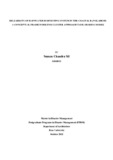Reliability of rainwater harvesting system in the coastal Bangladesh: a conceptual framework for cluster approach Tank Sharing Model

View/Open
Date
2022-10Publisher
Brac UniversityAuthor
Sil, Suman ChandraMetadata
Show full item recordAbstract
Despite having an average annual rainfall of 2400mm- 2600mm rainwater harvesting is still considered as “Seasonal solution” for drinking water sources in the coastal area of Bangladesh. Given the phenomenon of “Too much or too little rainfall” during different seasons that result in a huge waste of rainwater makes it difficult to design a rainwater harvesting system that can provide adequate and year-round drinking water yet economically feasible for the low-income households. However, the needs for drinking water, especially in the multi-hazards coastal area of Bangladesh is a “must-have” survival issue that goes beyond any technical or economic feasibility framework. This leads to a quest of designing a rainwater system, specifically the storage tank which is more “reliable” as well as “affordable” for the low-income households including the 35 million people living in the coastal area of Bangladesh. Employing a mixed method approach in combination of literature review, Simple Random Survey (SRS), Focus Group Discussion (FGD), in-depth interviews and hypothetical scenario analysis, this paper introduces the “Cluster Approach Tank Sharing model” and presents the result which shows improved “Reliability” of the rainwater harvesting system. The concept “Tank Sharing” used in this study has already been proven successful in the “Off-grid” smart energy sharing (solar) and decentralized water supply as well as sewage system design. The result of this study can potentially be used by different stakeholders including the government, NGOs, and the private sector to scale up the rainwater harvesting systems, especially in the water-stressed settings such as the coastal area of Bangladesh. This scale-up of the rainwater harvesting system will contribute to achieving SDG 6 targets by providing more “reliable” and “affordable” drinking water for all and thus contributing to the economic progress while keeping the environment safe.
